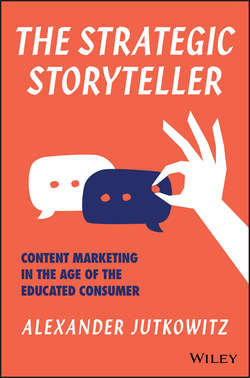Читать книгу The Strategic Storyteller - Jutkowitz Alexander - Страница 4
На сайте Литреса книга снята с продажи.
Introduction: A Call for Storytellers
ОглавлениеIf we cannot tell a story about what happened to us, nothing has happened to us.
– James P. Carse
The world is in dire need of stories. Information is abundant, but stories are rare.
It is not a subjective impression that our lives are getting faster and more complex. We are speaking faster than we were a decade ago, perhaps because we have more to say given that the amount of data in the world is growing at a rate of 60 percent per year.
In response, organizations have grown 35 times more complex over the past seven decades. For those of us who live our lives inside organizations, lead them, or communicate for them, this means that our day‐to‐day experience is ever tougher to manage.
As if this were not enough, the stories we get about the world are not in agreement with one another. Open the pages of any major news outlet, and you will find stories of precarious societies riven by violence, ideological conflict, and environmental collapse. Yet against this continuous buzz of catastrophe, it is also somehow true that the share of the global population living in extreme poverty has fallen by 50 percent since 1990. Which story to believe? And if both are to be believed, what larger story can explain them both?
If we're going to make sense of all this, we need more storytellers. We need more people with the tools and the desire to dig into the world's information and build their own stories out of it.
As digital technology breaks down the barriers between jobs, sooner or later all of us will be asked to tell stories in the course of our professional lives. We will be asked to make a case for ourselves, our work, our companies, and our future.
This is good news, because when we tell stories, unique and useful things happen.
Storytelling flexes the same muscles that allow organizations to pivot quickly around crisis or opportunity. To construct a coherent story requires that we make connections between parts of ourselves and our companies that wouldn't otherwise exist. Having these connections ready can mean the difference between survival or failure when we are met by the inevitable shocks of the future.
Innovation and creativity are the defining words of this collective moment. Key to both is the ability to take whatever raw materials are in front of us and recombine them in new ways. These raw materials can be ideas, physical assets, parts of organizations, and the talents of the people who work for them. And when we tell stories about ourselves and our institutions, we have no choice but to learn everything we can about these raw materials, and often we have to go in search of new ones. The raw materials that make up the solutions to our toughest problems are a kind of useful industrial by‐product of the storytelling process.
Storytelling is also an inherently disruptive activity.
On a personal level, it means that strategic storytellers must expand their capabilities and learn to think in new ways. In the course of telling a story, they might wear the hat of a consultant, artist, detective, journalist, or executive.
On an organizational level, storytelling requires us to find new language and images to represent our goals and our purpose that can be understood by a wider audience, not just the small circles that already speak our jargon. By making our purpose clear to others, we make it clear to ourselves.
On a strategic level, a fully grown storytelling function within an organization can mean the difference between life and death. Stories are the lifeblood of political campaigns. In the history of U.S. politics, it's the figures with the best stories that also radiate the most power, even generations after their deaths. We all know a few anecdotes or have a general sense of the personal brand of our greatest presidents, like Washington, Lincoln, and Teddy Roosevelt. In contemporary politics, the right story can win or lose an election, pass a piece of legislation, or end a war. In business, the right story defines any company's most valuable asset: its brand.
Stories are the base unit of reputation. Not to tell your own is to have no reputation or to cede its construction to others.
And that's where this book comes in. In it are the tools to build stories in a new way that coexists with the accelerated, complex tempo of our lives.
Our most important stories don't just live in the static pages of books any more. They are shaped and told digitally, at high speed, and emerge just a half step behind experience. They are consumed and made in small windows of time and in little sips of attention.
It is my firm belief that these conditions do not lessen our stories – but only make them richer. In fact, the rapid pace and diffusion of our stories – what I call their velocity and atomization – are making storytelling a lot more fun.
In that spirit, what you'll find in this book does not need to be consumed in order – or even in its entirety – to be useful. It's my hope that you can dip into this book at any spot for a bit of inspiration or for your next urgently needed idea.
When you need to be a storyteller any page of this book, consumed in whatever niche of time you might have, is here to help.
So let's advance to the next the page (whether digital or analog) and find not just my story but the beginning of yours, too.
